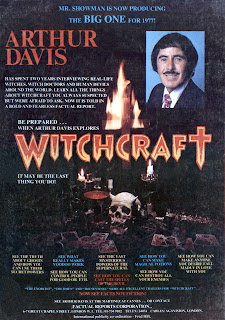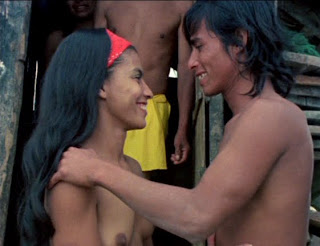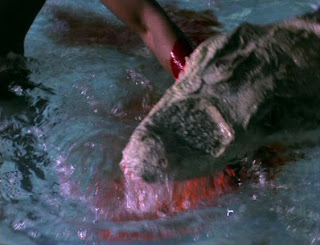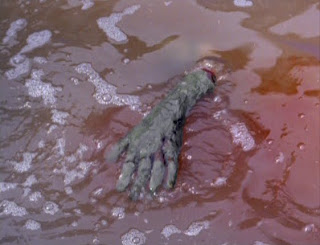The sci-fi thriller PHASE IV, graphic designer Saul Bass’s only feature film as director, had a chilly reception from audiences in 1974 and fell into obscurity for many years. Thanks to home video, an appearance on Mystery Science Theater 3000, and recent screenings that restored Bass’s original ending, the film has gained something of a cult following.
Award-winning sci-fi author Barry N. Malzberg penned a novelization of PHASE IV for Pocket Books. Malzberg called the Mayo Simon screenplay “wretched” (The Business of Science Fiction 62) and claims to have written the book in four or five days (60), yet his adaptation seems unhurried and is a strong example of developing thinly drawn characters and motivations for another medium. It differs significantly from the film in the way it presents the evolutionary climax and its build-up almost exclusively from the humans’ perspective, detailing the events as a psychological suspense tale quite unlike the clinical approach of the film.
At a research outpost in the Arizona desert, senior scientist Hubbs (Nigel Davenport) and cryptology specialist Lesko (Michael Murphy) investigate the death of livestock and various insect species at a nearby, and abandoned, housing development. Hubbs traces the deaths to an aggressive strain of ants that are being controlled by an extraterrestrial intelligence emanating from a cluster of dirt monoliths. Lesko attempts to understand the ants by breaking down their actions and communication patterns but Hubbs, impatient for a reaction from the insects, destroys the dirt towers.
Mr. and Mrs. Eldridge and granddaughter Kendra (Lynne Frederick) live nearby and have stubbornly refused to leave despite a government order. One night the ants attack Kendra's horse and eat it alive, and the Eldridges flee their home, seeking shelter at Hubbs's outpost. When Hubbs sprays pesticide as a defense against the insects, the Eldridges are killed and Kendra ends up with the two scientists. Meanwhile, the ants adapt to Hubbs’s insecticide and lay siege to the outpost, cutting off power and leaving the humans helpless. Eventually, only Lesko remains to locate the ant queen and exterminate her. He must descend into the earth and confront Kendra, who may be the queen in human form.
The release version sees Kendra, presumably under the influence of the ants, leading Lesko to his fate in an abrupt, bizarre, and downbeat conclusion. Bass and Simon’s original climax was a montage of hallucinatory visuals that depicted “Phase IV” as a melding of humanity and insect into the next stage of existence. This ending was shortened before the film's release, but the full version has been screened recently and the finale can be seen on YouTube. Because of the uplifting music score and Bass’s poetic, visionary images, the original ending seems optimistic about the human race: It’s implied that “Phase IV” is a natural adaptation of humans and insects to ensure survival.
Bass and Simon develop their theme by allotting more-or-less equal screen time for humans and ants, this shared dramatic perspective acting as a metaphor for the climactic fusion of species. The scenes between Hubbs, Lesko and Kendra alternate with footage of real insects photographed by Ken Middleham. The two perspectives complement each other, so that we see both Hubbs’s attempt to eradicate the ants and the insects' calculated defense, which involves a worker ant carrying a morsel of pesticide to its queen to absorb and adapt to the poison and hatch new eggs. Bass and Middleham also capture a suspenseful confrontation between two ants and a praying mantis that leads to the destruction of the air conditioners and the humans’ increasing madness.
In the novelization, this structure is largely ignored. Although Malzberg focuses on the ants mostly in opening and concluding sections, the bulk of his text alternates third-person narrative favoring Lesko -- and, in a few brief scenes, Kendra -- with Lesko's first-person diary entries. Malzberg explains that he designed the adaptation as such to keep from “running out of story [by] page 23," (62) but the effect is one of heightened tension, so that even in the absence of an immediate threat the novel’s tone becomes unnerving. Unlike the film, it’s not always clear if the ants are attacking the outpost and, as Lesko’s psychological state slowly deteriorates, a reader may wonder if the diary entries are meant to be a delusion (Malzberg has used an unreliable narrator several times, most notably in his 1972 novel Beyond Apollo). The author’s contempt for the source material can be glimpsed at times, such as Lesko comparing his situation to “one of those idiotic obligatory scenes at the end of a dramatic second act when characters talk to one another ponderously” (Malzberg 93), but even then humor and self-consciousness bring a certain plausibility.
Not surprisingly, considering how much of the plot is told from his perspective, Lesko emerges a more fully developed character. In the novel he comes off as lonely, depressed and sexually frustrated, with concerns that in two decades’ time he will be a clinical neurotic like Hubbs. It’s difficult not to sympathize with Lesko when Hubbs is initially characterized as “demoniac,” “possessed,” and “psychopathic,” the unpleasant next phase of Lesko’s personality if the younger scientist continues down a path of antisocial behavior.
As the novel progresses, Lesko’s reactions to his superior range from admiration to disgust, an interesting contradiction that the film never approaches. Hubbs is more likely to act impulsively, and when he suddenly destroys the towers to spur the insects to action, Lesko vocally objects but secretly admires Hubbs for having a “certain force and courage that had led him to perform precisely that act that I would have if I had had the authority … and the imagination” (47). In the film and novel Lesko is clearly upset when Hubbs's pesticide kills the Eldridges and the family's employee, Clete, but his anger at Hubbs weakens as both men struggle to stay alive against the insect siege.
Kendra, too, becomes a stronger character. In the film she is little more than beautiful and naive, and never seems to care that Hubbs and Lesko were responsible for her grandparents' deaths. Malzberg, however, writes Kendra as perceptive and intelligent. Shortly after arriving at the outpost, she assumes that both Hubbs and Lesko are "insane" and humors them in order to stay alive. Her innocence is basically an act, and yet, she finds herself drawn to Lesko and sees some integrity in him. In one scene she correctly deduces the relationship between the scientists and challenges Lesko:
She held that curious, intense look on me.
“You’re afraid of him, aren’t you?” she said.“Not exactly. But I am his assistant.”“All right,” she said. “You’re not afraid of him.”There was nothing else to say. She still looked at me levelly; she would have held that position indefinitely (87).
Strangely enough, sections from the Phase IV novelization found their way into Bass's film. As Malzberg recalls in The Business of Science Fiction: Two Insiders Discuss Writing and Publishing, post-production dragged on for so long that the author turned in his manuscript about ten months before the film premiered. When Malzberg and his editor finally viewed Bass’s work, they noticed that a passage from the novelization had been used in Lesko’s voiceover narration (63). Although the author receives no credit (and, according to him, no additional compensation), the narration provided as Lesko travels to the ant queen’s lair is an edited version of the protagonist's final diary entry from pages 151-153.
[EDIT: Sean Savage, who wrote an article on PHASE IV and studied the various drafts of Simon's screenplay, debunks Malzberg's claim. See Sean's post in the comments section.]
I would still like to believe that, given time, we could have come to an understanding. Some rational accommodation of interests. Some agreement. But that's not the way it's going to be. I've made some calculations about their rate of expansion using their intelligence, their powers of organization, their network of communications, the poisons, their ability to adapt genetically. I believe that after this test run they'll move rather quickly into desert areas, taking over the countryside first, then laying siege to towns and cities. I believe that they will learn as they advance, anticipating our moves and continue to stay a move ahead. We have only one chance: The counterattack suggested by Dr. Hubbs. A direct assault on their queen. Jesus, I wish it wasn't me.
Works Cited
Malzberg, Barry N. Phase IV. New York: Pocket Books, 1973. Print.
Resnick, Mike, and Barry N. Malzberg. The Business of Science Fiction: Two Insiders Discuss Writing and Publishing. Jefferson, NC: McFarland & Co., 2010. Print.





















































